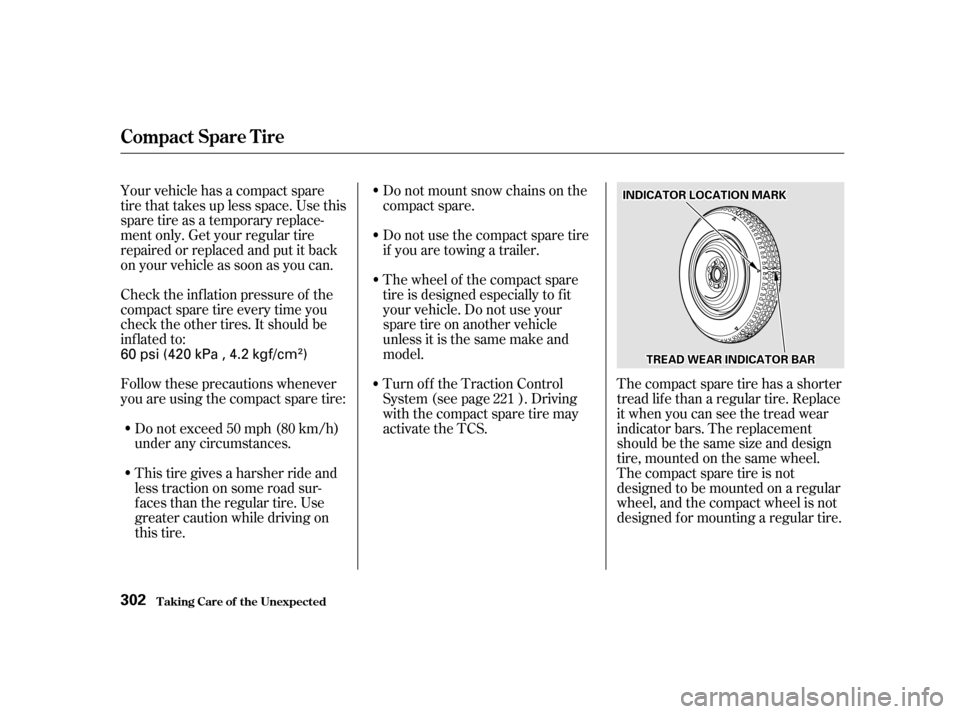Page 221 of 363

When starting out or driving at low
speeds on a loose or slippery road
surface, you may notice that the
vehicle does not respond to the
accelerator in the same way it does
at other times. This is a sign the TCS
is activating. You will see the TCS
indicator light f lash.
You should still install winter tires on
your vehicle during the winter. Make
sure to use the same size originally
supplied with vehicle. Exercise the
samecautioninwinterdrivingasyou
would if your vehicle was not
equipped with TCS.
Driving with the compact spare tire
installed (see page ) may
activate the TCS. You should turn of f
the system.If the brakes overheat while the TCS
is activating, the TCS indicator will
stop flashing and stay on temporarily.
This indicates that the TCS system
has turned of f . Af ter the brakes have
cooled down (usually f or about 10
minutes), the TCS will turn back on
and the indicator will turn of f .
This switch is under the side vent. It
letsyouturntheTractionControl
System on and of f . You cannot turn
of f the TCS while the TCS indicator
light is f lashing.
Deactivate the system by pressing
the TCS On/Off switch. The TCS
indicator light comes on as a
reminder. Pressing the switch again
turns the system back on.
302
Traction Control System
Driving
TCS ON/OFF Switch
222
TTCCSSOONN//OOFFFFSSWWIITTCCHH
Page 230 of 363

Your vehicle tires and spare are
properly inf lated (see page ),
and the trailer tires and spare are
inf lated as recommended by the
trailer maker.
When towing a trailer, you should
carry a f ull-size wheel and tire as a
spare in case you have a flat. If you
use the compact spare tire that came
with the vehicle, it may adversely
af f ect vehicle handling. See page
f or inf ormation on proper tire
size, and page f or inf ormation on
how to store a f ull-size tire. When
storing a f ull-size spare tire in the
trailer, f ollow the trailer maker’s
instructions.
Many states and Canadian provinces
require special outside mirrors when
towing a trailer. Even if they don’t,
you should install special mirrors if
you cannot clearly see behind you, or
if the trailer creates a blind spot.
Askyourtrailersalesorrental
agency if any other items are
recommended or required f or your
towing situation. When preparing to tow, and bef ore
driving away, be sure to check the
f ollowing:
The vehicle has been properly
serviced, and the tires, brakes,
suspension, and cooling system
are in good operating condition.
All weights and loads are within
limits (see pages and ).
Thehitch,safetychains,andany
other attachments are secure.
Allitemsonandinthetrailerare
properly secured and cannot shif t
while you drive.
The lights and brakes on your
vehicle and the trailer are working
properly. You may want to fill the fuel tank
with premium f uel. Premium f uel
provides improved perf ormance.
323
309
227 228 335
CONT INUED
Spare Vehicle T ire
Additional Trailer EquipmentPre-T ow Checklist
Towing a Trailer
Driving231
Page 273 of 363

The following chart shows the
recommended cold tire pressures f or
most normal driving conditions and
speeds. Tire pressures f or high
speed driving are the same as f or
normal driving.
Thecompactsparetirepressureis:
If you check the pressure when the
tires are hot (the vehicle has been
driven several miles), you will see
readings 4 to 6 psi (30 to 40 kPa, 0.3
to 0.4 kgf/cm ) higher than the cold
reading. This is normal. Do not let
air out to match the specified cold
pressure. The tire will be
underinf lated.
Youshouldgetyourowntire
pressure gauge and use it whenever
you check your tire pressures. This
will make it easier f or you to tell if a
pressure loss is due to a tire problem
and not due to a variation between
gauges.
Use a gauge to measure the air
pressure at least once a month. Even
tires that are in good condition may
lose one to two psi (10 to 20 kPa, 0.1
to 0.2 kgf /cm ) per month.
Remember to check the spare tire at
thesametimeyoucheckallthe
other tires.
Check the pressure in the tires when
they are cold. This means the vehicle
has been parked f or at least three
hours. If you have to drive the
vehicle bef ore checking the tire
pressure, the tires can still be
considered ‘‘cold’’ if you drive less
than 1 mile (1.6 km).
Tire Size Cold Tire Pressure
for Normal Driving
Tires
Maint enance
Recommended T ire Pressures f or
Normal Driving
274 P215/65R16 96T 35 psi (240 kPa , 2.4
kgf/cm
)
60 psi (420 kPa , 4.2 kgf/cm
)
Page 300 of 363

This section covers the more-
common problems that motorists
experience with their vehicles. It
gives you inf ormation about how to
safely evaluate the problem and what
to do to correct it. If the problem has
stranded you on the side of the road,
you may be able to get going again.
If not, you will also f ind instructions
on getting your vehicle towed.......................
Compact Spare Tire . 302
....................
Changing a Flat Tire . 303
..........
If Your Engine Won’t Start . 312
Nothing Happens or theStarter Motor Operates ........................
Very Slowly . 312
The Starter Operates ................................
Normally . 313
................................
Jump Starting . 313
............
If Your Engine Overheats . 315
.........
Low Oil Pressure Indicator . 318
..........
Charging System Indicator . 319
.......
Malf unction Indicator Lamp . 320
.......................
Readiness Codes . 321
...............
Brake System Indicator . 322
..............................................
Fuses . 323
..........
Checking and Replacing . 324
......................
Emergency Towing . 329
Taking Care of the Unexpected
T aking Care of t he Unexpect ed 301
Page 301 of 363

Your vehicle has a compact spare
tire that takes up less space. Use this
sparetireasatemporaryreplace-
ment only. Get your regular tire
repaired or replaced and put it back
on your vehicle as soon as you can.Thecompactsparetirehasashorter
tread lif e than a regular tire. Replace
it when you can see the tread wear
indicator bars. The replacement
shouldbethesamesizeanddesign
tire, mounted on the same wheel.
Thecompactsparetireisnot
designed to be mounted on a regular
wheel, and the compact wheel is not
designed f or mounting a regular tire.
Check the inf lation pressure of the
compact spare tire every time you
check the other tires. It should be
inf lated to:
This tire gives a harsher ride and
less traction on some road sur-
f aces than the regular tire. Use
greater caution while driving on
this tire.
Do not exceed 50 mph (80 km/h)
under any circumstances.
Follow these precautions whenever
you are using the compact spare tire: Do not mount snow chains on the
compact spare.
Do not use the compact spare tire
if you are towing a trailer.
The wheel of the compact spare
tire is designed especially to f it
your vehicle. Do not use your
sparetireonanothervehicle
unlessitisthesamemakeand
model.
Turn off the Traction Control
System (see page ). Driving
withthecompactsparetiremay
activate the TCS.
221
Compact Spare Tire
T aking Care of t he Unexpect ed
302
IINNDDIICCAATTOORRLLOOCCAATTIIOONNMMAARRKK
TTRREEAADDWWEEAARRIINNDDIICCAATTOORRBBAARR
60 psi (420 kPa , 4.2 kgf/cm)
Page 303 of 363
Open the tailgate. Take the tools out of the storagecompartment.The spare tire is stored under the
f loor between the f irst and second
row of seats. If the f ront seats are
adjusted to the rear-most position,
move the seats f orward slightly
and adjust the seat-backs to an
upright position (see page ).
Lift up the center table (see page
).
Turn the jack’s end bracket
counterclockwise to loosen it, then
remove the jack.
Remove the cargo net.
Thetoolsandjackarebehinda
cover in the cargo area on the
driver’s side. Remove the cover by
turning the handle
counterclockwise, then pulling out
the cover.
3. 4.
5.6.7.
105
123
Changing a Flat T ire
T aking Care of t he Unexpect ed
304
CCOOVVEERR
Page 304 of 363
CONT INUED
Open either of the rear sliding
doors. Pull the f loor carpet up by
lif ting up on the edge, then raise
the f loor lid by pulling up on the
handle. To keep the f loor carpet
and lid out of the way, pull out the
hook on the back of the f loor lid
and attach it into the seat-back
handle on the driver’s seat.Remove the spare tire basket.
Unscrew the wing bolt and take
the spare tire out of its well. After
you have removed the spare tire,
screw this wing bolt back into
place.
Loosen the f ive wheel nuts 1/2
turn with the wheel wrench.
If you are changing a rear tire,
close the sliding door. Then turn
of f the sliding door MAIN switch.
8.
9.
11. 12.
10.On EX model On EX model
Changing a Flat T ire
T aking Care of t he Unexpect ed
305
WWHHEEEELLNNUUTTSS
HHOOOOKK
HHAANNDDLLEE
WWIINNGGBBOOLLTT
SSPPAARREETTIIRREEBBAASSKKEETT
SSPPAARREETTIIRREE
Page 306 of 363
Put on the spare tire. Put the
wheel nuts back on f inger-tight,
then tighten them in a crisscross
pattern with the wheel wrench
until the wheel is f irmly against
the hub. Do not try to tighten
them f ully.
Bef ore mounting the spare tire,
wipeanydirtoff themounting
surface of the wheel and hub with
a clean cloth. Wipe the hub
carefully,itmaybehotfrom
driving.
Do not attempt to forcibly pry the
wheel cover of f with a screwdriver or
other tool. The wheel cover cannot
be removed without f irst removing
the wheel nuts. 16. 17.
CONT INUED
On LX model
Changing a Flat T ire
T aking Care of t he Unexpect ed
307
BBRRAAKKEEHHUUBB
WWHHEEEELLCCOOVVEERR